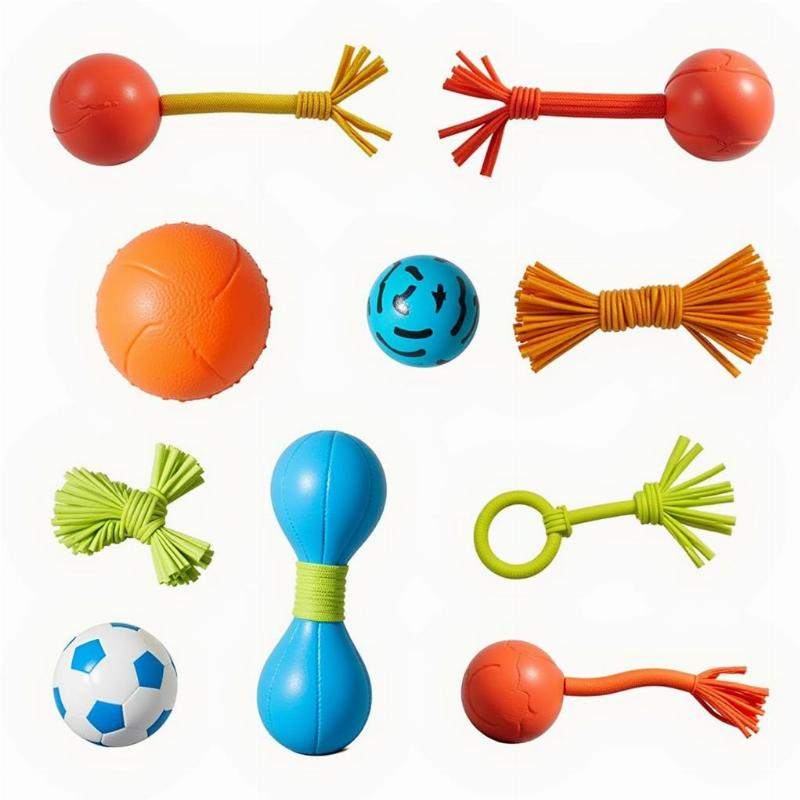If your furry friend has a penchant for disemboweling their plush pals and indulging in a little stuffing snack, you’re not alone. Many dog owners type “dog eating stuffing from toy” into search engines, worried about the potential health risks. While it’s usually not a life-threatening situation, there are some important factors to consider. This article will explore the dangers of dogs eating toy stuffing, offer preventative measures, and provide guidance on when to seek veterinary care.
Why Do Dogs Eat Toy Stuffing?
Several reasons can explain why a dog enjoys eating toy stuffing. For some, it’s simply the thrill of the hunt. The squeaking, the tearing, the ultimate victory of ripping out the fluffy insides can be incredibly stimulating for a dog’s prey drive. Other dogs might be teething puppies seeking relief from sore gums, while some might just be bored or anxious. Understanding the underlying reason can help you address the behavior more effectively.
The Dangers of Ingested Toy Stuffing
While small amounts of stuffing might pass through your dog’s digestive system without incident, larger quantities can pose significant risks. The stuffing can clump together in the stomach or intestines, leading to a blockage. This obstruction can prevent food and water from passing through, causing vomiting, lethargy, loss of appetite, and abdominal pain. In severe cases, surgery might be required to remove the blockage.
Another concern is the material of the stuffing itself. Some stuffings contain toxic chemicals that can be harmful if ingested. Additionally, sharp pieces from the toy itself can cause internal injuries as they are swallowed along with the stuffing.
What To Do If Your Dog Eats Stuffing
If your dog has consumed a small amount of stuffing, monitor them closely for any signs of discomfort or changes in their behavior. Look for vomiting, diarrhea, constipation, lethargy, or loss of appetite. If you notice any of these symptoms, contact your veterinarian immediately. If your dog has eaten a large amount of stuffing or shows signs of distress, seek emergency veterinary care.
Preventing Your Dog from Eating Stuffing
The best way to deal with this issue is prevention. Choose durable toys specifically designed for aggressive chewers. Look for toys made from tough materials that can withstand a lot of wear and tear. Avoid toys with easily detachable parts or those filled with small beads or pellets.
 Durable dog toys
Durable dog toys
Engaging Your Dog in Other Activities
Boredom and anxiety can often lead to destructive behaviors like toy shredding. Providing your dog with plenty of physical exercise and mental stimulation can help keep them entertained and less likely to focus on destroying their toys. Daily walks, playtime, and interactive toys like puzzle feeders can make a big difference.
When to Seek Veterinary Care
- Sudden changes in behavior: Lethargy, whining, pacing
- Vomiting or diarrhea: Especially if persistent or bloody
- Constipation or straining to defecate: A sign of potential blockage
- Loss of appetite: A key indicator of digestive issues
- Abdominal pain or distension: Your dog might appear hunched over or uncomfortable
FAQs
- Is all toy stuffing dangerous for dogs? While some stuffing is relatively harmless, the risk of blockage and potential toxicity makes it best to avoid any ingestion.
- What are the signs of an intestinal blockage? Vomiting, diarrhea, constipation, lethargy, loss of appetite, and abdominal pain.
- Can I give my dog bones instead of plush toys? Cooked bones should never be given to dogs as they can splinter and cause internal damage. Some raw bones are appropriate, but always supervise your dog and choose appropriately sized bones.
- What are some good alternatives to plush toys? Durable rubber toys, rope toys, and Kongs are excellent choices.
- How can I train my dog to stop destroying toys? Positive reinforcement training, providing plenty of exercise and mental stimulation, and choosing appropriate toys can all help.
- My dog ate a squeaker – should I be worried? Yes, ingesting a squeaker can be dangerous. Contact your veterinarian immediately.
- What kind of toys are best for aggressive chewers? Look for toys made from tough, durable materials like rubber or nylon.
Beautdogs.us is your premier destination for comprehensive and engaging information about dog care and companionship in the USA. We offer expert advice on dog breeds, grooming, training, and health, empowering both new and experienced dog owners to provide the best possible care for their furry friends. Discover a wealth of knowledge on our website, covering everything from breed-specific guides to the latest veterinary practices. Connect with us for personalized support and guidance! Beautdogs.us welcomes your inquiries at [email protected] or +1 501-555-7529.